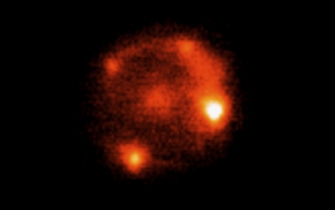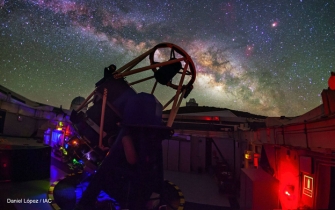
Merging black holes produce gravitational wave first detected by LIGO on Sept 15 2015. Image Credit: NASA
2016
17 JuneGROWTH astronomers ready to catch gravitational wave sources in action
GROWTH astronomers, who are also part of the iPTF collaboration were one of many teams who mobilized their telescope networks to scan the sky in search of electromagnetic radiation that could be coming from the source of the gravitational wave detected by LIGO last September. Just 2 hours after the arrival of LIGO's trigger, the complex iPTF algorithms sieved through thousands of potential sources in the sky, and narrowed them down to a handful, which were then observed in detail with larger telescopes around the world. The trigger heralded the arrival of a new era in astronomical discovery, and this coordinated follow-up effort announced that astronomers are ready for it.
The extraordinarily tiny ripples of space-time detected by LIGO last September served as the starting pistol for multiple teams of astronomers around the world who pointed telescopes of all sizes and frequency bands to the sky to look for photons that may tell them more about the origin and location of the gravitational wave source. They knew what kind of violent cosmic events could generate gravitational waves that can be detected by LIGO - merging black holes, merging neutron stars or a neutron start merging with a black hole. The first one is not expected to generate any electromagnetic radiation, but the last two cannot really hide from our telescopes if we can located them on the sky before they fade away. This is exactly what the international team of iPTF and GROWTH astronomers have been preparing for. In a paper, published today in the Astrophysical Journal Letters the group demostrated the capabilities of Palomar Observatory to swiftly scan large portions of the sky and identify promising candidates which can then be studied in detail with the multi-wavelength GROWTH network of telescopes within the first few hours after a LIGO trigger. As a result, astronomers are becoming confident that they can pinpoint the location of the gravitational wave sources and unravel a myriad of mysteries about the physics and chemistry associated with them.
Led by Dr Mansi Kasliwal, an assistant professor of Astronomy at Caltech, the team used the 1.2m Samuel Oschin Telescope, part of the Palomar Observatory to swiftly scan 126 square degrees of the sky region where the gravitational wave GW150914 could have originated from. 630 Moons can fit in this area, yet it covered only a tiny part of the entire area of interest much of which was in the southern hemisphere and therefore not visible to the Palomar and GROWTH telescopes. Within these 126 square degrees, the robotic telescope identified more than 150 000 potentially interesting objects. Plowing through these objects as fast as possible and eliminating the vast majority of them as variable sources, asteroids, known supernovae or active galactin nuclei is a major challenge facing astronomers. Advances in computing technology coupled with the continuously evolving machine learning algorithms employed by iPTF, allowed the team to successfully reduce the candidates from thousands to just 8. This managable number of sources could then be observed in multiple frequencies with the Keck telescope, VLA and Swift satellite, all part of the GROWTH network of global facilities.
After analysis of the data, none of the 8 candidates was associated with GW150914. Not surprising, given that we now know the gravitational wave originated from a merger of two black holes. But astronomy is rarely devoid of surprises. One of the studied objects was recognized as a hypernova, also known as superluminous supernova. One of the most catastrophic events in the Universe, tens to a hundred times more energetics than a supernova, hypernovas can provide a glimpse into the evolution and death of the most massive stars we know of. In the imminent quest to chase the electromagnetic radiation from gravitational wave events, astronomers will undoubtedly also stumble upon exotic new phenomena, which will give rise to new questions and new discoveries.
Contact
Iva Kostadinova
GROWTH Communications and Media Contact
ivonata@caltech.edu
+1 626 395 2952
Mansi Kasliwal
GROWTH Principal Investigator
mansi@astro.caltech.edu
+1 626 395 1575




